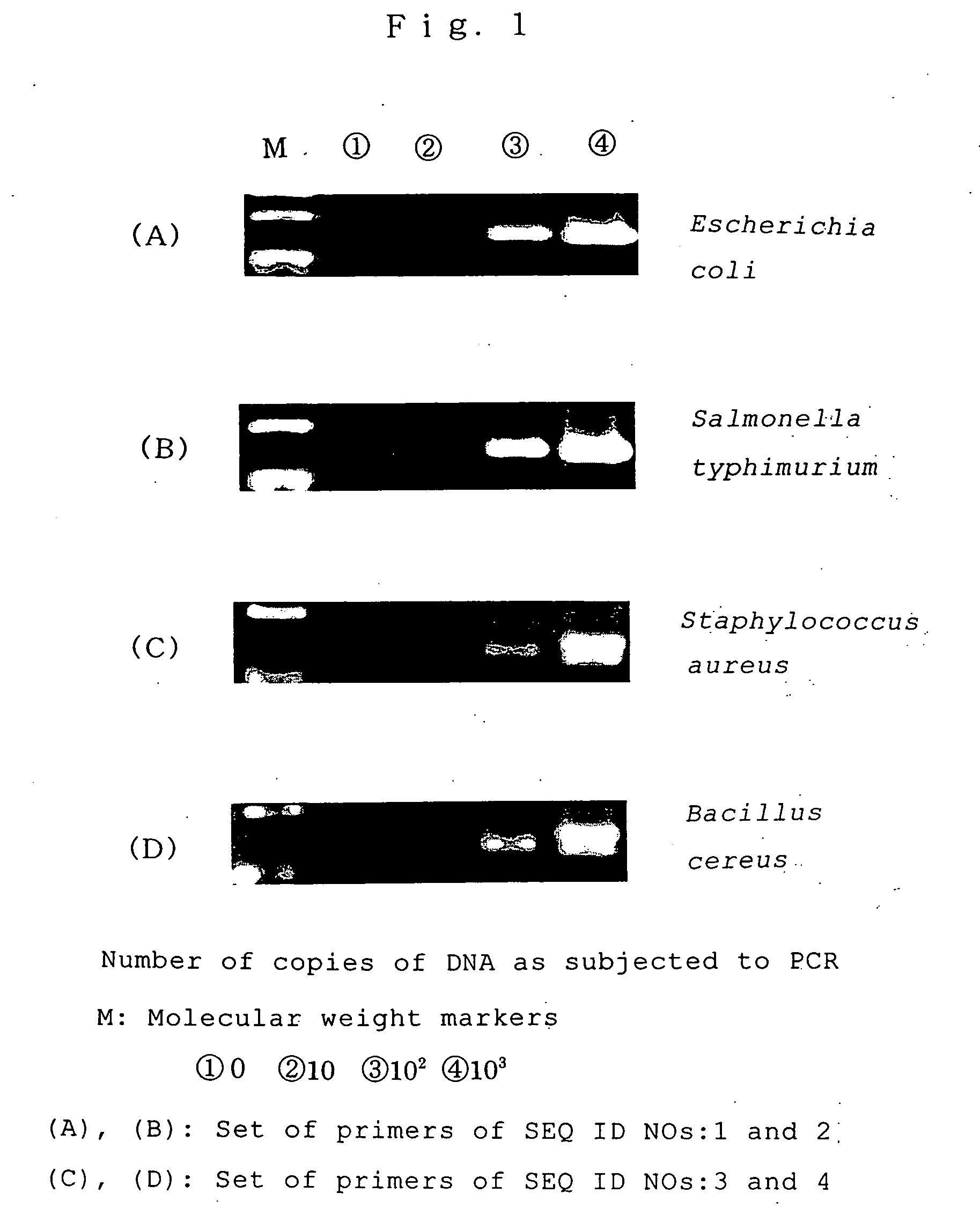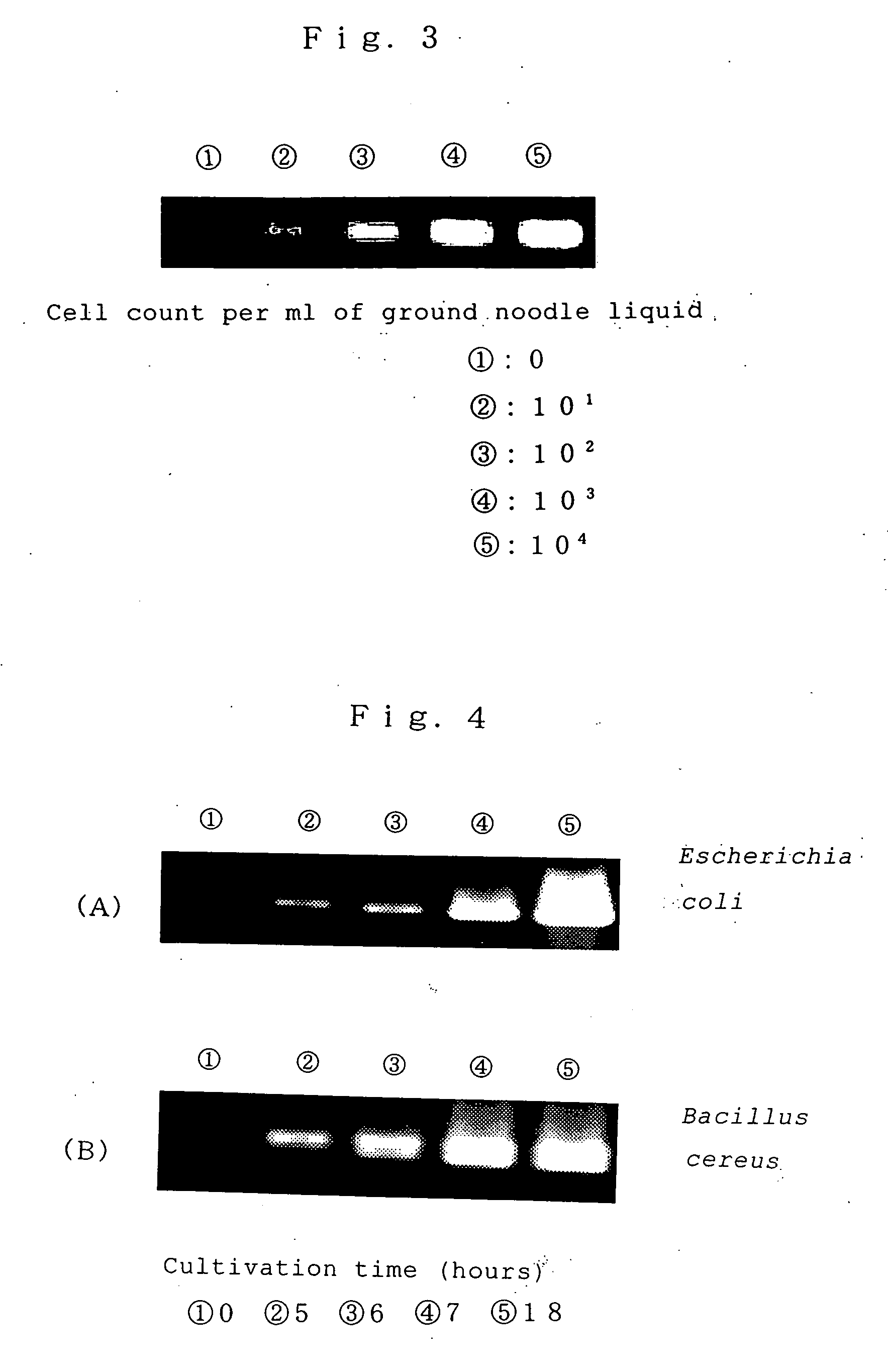Primers and method of detecting bacteria
- Summary
- Abstract
- Description
- Claims
- Application Information
AI Technical Summary
Benefits of technology
Problems solved by technology
Method used
Image
Examples
example 1
Confirmation of Reactivity in Type Strains
[0135] Bacterial strains of Escherichia coli JCM 1649T, Salmonella typhimurium IFO 13245, Staphylococcus aureus IFO 3060 and Bacillus cereus IFO 15305T were grown in brain heart infusion medium. Using DNeasy Tissue Kit (product of QIAGEN), DNA solutions were prepared from cells of the respective strains.
[0136] The DNA primers defined by SEQ ID NO:1, SEQ ID NO:2, SEQ ID NO:3 and SEQ ID NO:4 were synthesized using a DNA synthesizer.
[0137] The DNA amount in cells of each bacterial strain was determined, and test DNA solutions were prepared so that the genome copy number contained in the DNA solutions as estimated from the molecular weight of the genome of each bacterial strain might amount to about 10 copies / μl, about 102 copies / μl or about 103 copies / μl. Sterilized water and the buffer solution for PCR were added to 1 μl of each test DNA solution for adjustment to the following final concentrations: 2.0 mM MgCl2, 50 mM Tris-HCl (pH 8.3), 0....
example 2
Reactivity with Plant DNAs
[0143] Respective plant DNAs were extracted from commercially available wheat flour, potato, soybean and corn using DNeasy Plant Mini Kit (product of Qiagen).
[0144] After determination of the DNA concentration in each plant DNA extract prepared, test DNA solutions corresponding in genomic DNA copy number in each solution to about 100 copy / μl, about 101 copies / μl, about 102 copies / μl and about 103 copies / μl as estimated from the molecular weight of DNA per genome in each plant species were prepared. Sterilized water and the buffer solution for PCR were added to 1 μl of each of these test DNA solutions for adjustment to the following final concentrations: 2.0 mM MgCl2, 50 mM Tris-HCl (pH 8.3), 0.25 mg / ml BSA, 200 μM dNTPs, and 0.2 μM of each primer. Thereto was added 1.0 unit of Hot Start Taq DNA polymerase (product of Roche Diagnostics), and the PCR was carried out with a total liquid amount of 20 μl.
[0145] As for the primers, a set of the primer of SEQ I...
example 3
Confirmation of Species Specificity of the Primers of the Invention
[0150] The bacterial strains listed below in Table 1 were cultured in the same manner as in Example 1 using media suited for the strains, and the DNA was extracted from the culture of each strain and subjected to PCR. The primers used were the primer of SEQ ID NO:1 in combination with the primer of SEQ ID NO:2, and the primer of SEQ ID NO:3 in combination with the primer of SEQ ID NO:4.
[0151] The results are shown in Table 1.
TABLE 1Primers ofPrimers ofSEQ IDSEQ IDNos.:familyGenus, Species, and strainsNos.: 1 and 23 and 4RhizobiaceaeAgrobacterium radiobacter ATCC 19358T−−AlcaligenaceaeAlcaligenes faecalis JCM 1474T−−NeisseriaceaeChromobacterium violaceum JCM 1249T−−Neisseria meningitides ATCC 13077T−−XanthomonadaceaeXanthomonas maltophilia JCM 1975T−−LegionellaceaeLegionella pneumophila JCM 7571T−−PseudomonadaceaePseudomonas aeruginosa ATCC 27843T−−Pseudomonas fluorescens JCM 5963T−−MoraxellaceaeMoraxella antipest...
PUM
| Property | Measurement | Unit |
|---|---|---|
| Mass | aaaaa | aaaaa |
| Mass | aaaaa | aaaaa |
| Electrical conductance | aaaaa | aaaaa |
Abstract
Description
Claims
Application Information
 Login to View More
Login to View More - R&D
- Intellectual Property
- Life Sciences
- Materials
- Tech Scout
- Unparalleled Data Quality
- Higher Quality Content
- 60% Fewer Hallucinations
Browse by: Latest US Patents, China's latest patents, Technical Efficacy Thesaurus, Application Domain, Technology Topic, Popular Technical Reports.
© 2025 PatSnap. All rights reserved.Legal|Privacy policy|Modern Slavery Act Transparency Statement|Sitemap|About US| Contact US: help@patsnap.com



